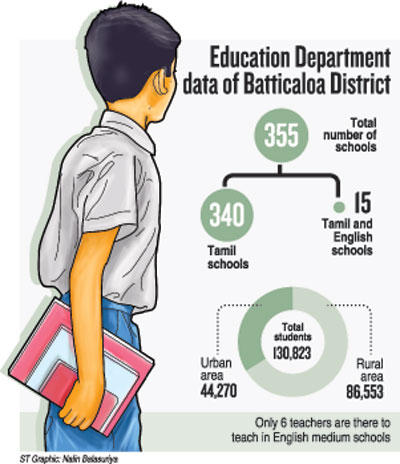News
Eastern schools face teacher crisis
View(s):Dropouts, low literacy add to education concerns
By Ravi Shankar in Batticaloa
A huge shortfall of English, Mathematics and Science teachers in Batticaloa schools is resulting in a severe deterioration in education levels.
There are 355 schools in the district’s three education zones, Kalkudah, Paddiruppu and Kannankuda, 340 schools in the Tamil medium and 15 in English medium.
 Education Department data reveals that there are only six qualified teachers to teach English in the 15 English medium schools and that of the 69 schools in Paddiruppu zone not a single school has a qualified teacher for English.“Apart from English, the schools in Paddiruppu zone lack 58 teachers to teach Science. We have informed senior officials about the insufficiency of teachers but no action has been taken,” the Zonal Director of Education of Paddiruppu, Mrs. N. Pullenayagam, said.,
Education Department data reveals that there are only six qualified teachers to teach English in the 15 English medium schools and that of the 69 schools in Paddiruppu zone not a single school has a qualified teacher for English.“Apart from English, the schools in Paddiruppu zone lack 58 teachers to teach Science. We have informed senior officials about the insufficiency of teachers but no action has been taken,” the Zonal Director of Education of Paddiruppu, Mrs. N. Pullenayagam, said.,
M. Satyanayagam, Principal of Viduthikkal School, admitted there were no English and Science teachers for the primary classes in his school. “At present, class teachers who are qualified in other subjects are taking these units but the children are weak in these subjects – that is evident when they sit their exams,” he said.
Schools that do not have teachers in English, Mathematics and Science are depending on teachers from faraway schools to conduct class test exams.
The Ceylon Teachers Association said that the insufficiency of teaching staff is because of the reluctance of teachers to go to rural areas where most of these schools are located. “The teachers are willing to work only in city areas such as Colombo. They are not willing to take postings to rural areas as many of the schools cannot be easily reached,” said Joseph Stalin, Secretary of the Ceylon Teachers Association.
The Batticaloa district has one of the lowest literacy rates in the country, and the highest number of school dropouts.
The District Secretariat of Batticaloa admits that the literacy rate of entire district is below 70 per cent, which is alarmingly low as compared to the 92 per cent literacy rate in the rest of the country. In some places it is less than 50 per cent, such as in Vakarai, where it is 47 per cent.
Poverty is the main reason for student dropouts.
“Because of the low family income, many students are forced to drop out of school to take on unskilled labour, mainly in agriculture and fishery,” the Principal of Mavadimunary school, Mr. Mahesharatnam said.
Nine out of 10 children attend school until the age of 14 but only 75 per cent come to classes in the 15-16 year age band, District Secretariat figures show.
“This year, more than 300 students have dropped out of school in our area,” the Zonal Education Officer for Kalkudah, S Srikrishnarajaha said. “Most of the dropouts are from the Vakarai area, which has the lowest literacy level in the district.”
Woefully, the dropout rate among girl students is high: marriage before the age of 15 and early pregnancy are the reasons for this, officials said.
Many of the students who drop out are looked after by single parents. A large number of mothers have gone overseas, mainly to the Middle East countries, for unskilled jobs. Their children are looked after by any available local guardian and they are reluctant to send the children to school, authorities said.
In the first nine months of this year, 450 mothers went to the Middle East. This figure is particularly disturbing as it reflects legal departures and the real figure would be higher.
While the dropout rate is a major concern the other worrying factor is irregular attendance at school, with some students attending classes only one day a week.
Of the 130,000 students in the district more than 85,000 are from rural areas. Most schools in rural areas only run classes up to Grade 5: after that, pupils have to attend a secondary school in town, far from their homes.
“About 90 per cent of the students live close to a forest area so elephants are a problem that affects school attendance,” the Zonal Director of Education of Kannankudha region, K. Satyanathan, said. “Two months ago, a female student was killed by an elephant at Eraticholaimadiya when she was going back home after school. Also, when it rains the paths to schools become impassable so many students are not able to attend the classes regularly.”
Asked for comment, an Education Department spokesperson said strict guidelines had been given to principals over dropouts and irregular attendance but “the issue cannot be tackled by the Education Department alone. It needs the collaborative efforts of other ministries as the issue involves the difficulties experienced by students facing by poverty and transportation.”

